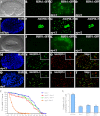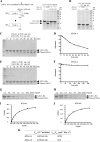Differential function of the two Atg4 homologues in the aggrephagy pathway in Caenorhabditis elegans
- PMID: 22767594
- PMCID: PMC3436130
- DOI: 10.1074/jbc.M112.365676
Differential function of the two Atg4 homologues in the aggrephagy pathway in Caenorhabditis elegans
Abstract
The presence of multiple homologues of the same yeast Atg protein endows an additional layer of complexity on the autophagy pathway in higher eukaryotes. The physiological function of the individual genes, however, remains largely unknown. Here we investigated the role of the two Caenorhabditis elegans homologues of the cysteine protease Atg4 in the pathway responsible for degradation of protein aggregates. Loss of atg-4.1 activity causes defective degradation of a variety of protein aggregates, whereas atg-4.2 mutants remove these substrates normally. LGG-1 precursors accumulate in atg-4.1 mutants, but not atg-4.2 mutants. LGG-1 puncta, formation of which depends on lipidation of LGG-1, are present in atg-4.1 and atg-4.2 single mutants, but are completely absent in atg-4.1; atg-4.2 double mutants. In vitro enzymatic analysis revealed that ATG-4.1 processes LGG-1 precursors about 100-fold more efficiently than ATG-4.2. Expression of a mutant form LGG-1, which mimics the processed precursor, rescues the defective autophagic degradation of protein aggregates in atg-4.1 mutants and, to a lesser extent, in atg-4.1; atg-4.2 double mutants. Our study reveals that ATG-4.1 and ATG-4.2 are functionally redundant yet display differential LGG-1 processing and deconjugating activity in the aggrephagy pathway in C. elegans.
Figures






Similar articles
-
Guidelines for monitoring autophagy in Caenorhabditis elegans.Autophagy. 2015;11(1):9-27. doi: 10.1080/15548627.2014.1003478. Autophagy. 2015. PMID: 25569839 Free PMC article. Review.
-
The two C. elegans ATG-16 homologs have partially redundant functions in the basal autophagy pathway.Autophagy. 2013 Dec;9(12):1965-74. doi: 10.4161/auto.26095. Autophagy. 2013. PMID: 24185444 Free PMC article.
-
Aggrephagy: lessons from C. elegans.Biochem J. 2013 Jun 15;452(3):381-90. doi: 10.1042/BJ20121721. Biochem J. 2013. PMID: 23725457 Review.
-
Structural Basis of the Differential Function of the Two C. elegans Atg8 Homologs, LGG-1 and LGG-2, in Autophagy.Mol Cell. 2015 Dec 17;60(6):914-29. doi: 10.1016/j.molcel.2015.11.019. Mol Cell. 2015. PMID: 26687600
-
Small differences make a big impact: Structural insights into the differential function of the 2 Atg8 homologs in C. elegans.Autophagy. 2016;12(3):606-7. doi: 10.1080/15548627.2015.1137413. Autophagy. 2016. PMID: 27046254 Free PMC article.
Cited by
-
Guidelines for monitoring autophagy in Caenorhabditis elegans.Autophagy. 2015;11(1):9-27. doi: 10.1080/15548627.2014.1003478. Autophagy. 2015. PMID: 25569839 Free PMC article. Review.
-
Linear motifs regulating protein secretion, sorting and autophagy in Leishmania parasites are diverged with respect to their host equivalents.PLoS Comput Biol. 2024 Feb 16;20(2):e1011902. doi: 10.1371/journal.pcbi.1011902. eCollection 2024 Feb. PLoS Comput Biol. 2024. PMID: 38363808 Free PMC article.
-
You are what you eat: multifaceted functions of autophagy during C. elegans development.Cell Res. 2014 Jan;24(1):80-91. doi: 10.1038/cr.2013.154. Epub 2013 Dec 3. Cell Res. 2014. PMID: 24296782 Free PMC article. Review.
-
Conserved components of the macroautophagy machinery in Caenorhabditis elegans.Genetics. 2025 Apr 17;229(4):iyaf007. doi: 10.1093/genetics/iyaf007. Genetics. 2025. PMID: 40180610 Free PMC article. Review.
-
New label-free automated survival assays reveal unexpected stress resistance patterns during C. elegans aging.Aging Cell. 2019 Oct;18(5):e12998. doi: 10.1111/acel.12998. Epub 2019 Jul 16. Aging Cell. 2019. PMID: 31309734 Free PMC article.
References
-
- Xie Z., Klionsky D. J. (2007) Autophagosome formation: core machinery and adaptations. Nat. Cell Biol. 9, 1102–1109 - PubMed
-
- Nakatogawa H., Suzuki K., Kamada Y., Ohsumi Y. (2009) Dynamics and diversity in autophagy mechanisms: lessons from yeast. Nat. Rev. Mol. Cell Biol. 10, 458–467 - PubMed
-
- Ohsumi Y. (2001) Molecular dissection of autophagy: two ubiquitin-like systems. Nat. Rev. Mol. Cell Biol. 2, 211–216 - PubMed
-
- Kirisako T., Ichimura Y., Okada H., Kabeya Y., Mizushima N., Yoshimori T., Ohsumi M., Takao T., Noda T., Ohsumi Y. (2000) The reversible modification regulates the membrane-binding state of Apg8/Aut7 essential for autophagy and the cytoplasm to vacuole targeting pathway. J. Cell Biol. 151, 263–276 - PMC - PubMed
-
- Yoshimori T., Noda T. (2008) Toward unraveling membrane biogenesis in mammalian autophagy. Curr. Opin. Cell Biol. 20, 401–407 - PubMed
Publication types
MeSH terms
Substances
LinkOut - more resources
Full Text Sources
Molecular Biology Databases
Research Materials

